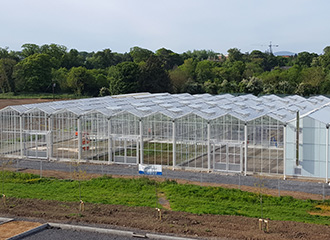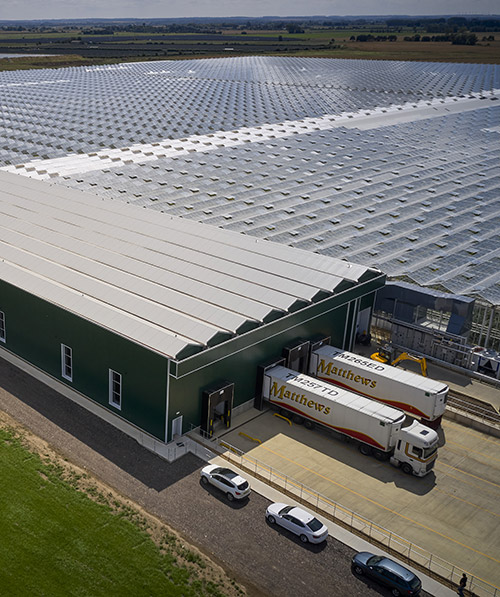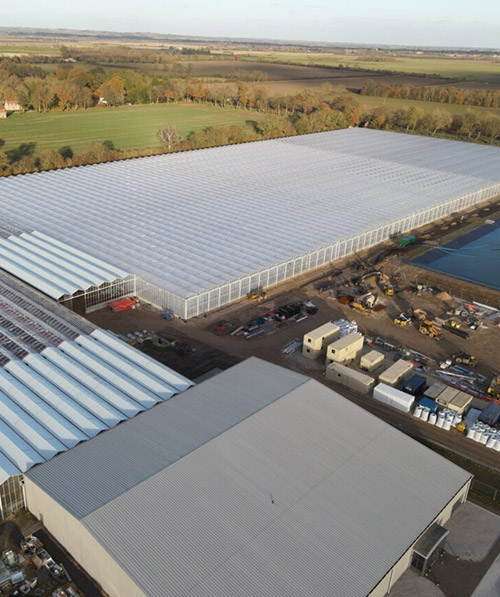Call Today 01430 449440
How six innovations are shaping the future of greenhouse farming
THEY definitely don't capture the headlines in the same way as vertical farms, but greenhouses still play a vital role in global food production.
Having helped to cultivate indoor crops for thousands of years, it's safe to say this age-old growing technique will be around for a few years yet.
Thanks to advances in technology, the humble glasshouse can now be transformed into a precisely-controlled growing environment that farmers can rely on to achieve improved yields and profits.
At CambridgeHOK, we're proud to have been appointed as the build partner for Beeswax Dyson Farming - Britain's biggest privately-owned farming business - for a new multi-million-pound state-of-the-art indoor strawberry production facility.
In terms of its size, complexity, sophistication and green credentials; the Lincolnshire development will be the first of its kind in the UK horticulture market.
As the 'buy local' trend continues to grow, we're sure the technology used on this project will soon be replicated by growers across the UK.
In this article, we'll outline all the biggest benefits that modern technology can now bring to the greenhouse industry.
What greenhouse farming technologies are there?
1. Intelligent automation
Automated irrigation systems, pH sensors and climate control software can all be used to solve common problems faced by indoor farmers, such as disease prevention and pest management.
By using wireless sensors, it's possible to accurately monitor real-time temperatures (and fluctuations) to maintain an optimum growing environment. Depending on the fruit or vegetables you want to produce, this could be the difference between a seasonal yield or year-round production.
At CambridgeHOK, we can provide user-friendly integrated automation solutions to increase efficiency, profit and sustainability.
Alongside this we regularly install automated solutions to move plants/product across the site through automated vehicle or benching solutions. Across larger sites we are seeing excellent returns on investment for this type of technology.
2. Self-sufficient water systems
When it comes to water usage, most glasshouses can become self-sufficient if the right rainwater harvesting system is put in place.
Instant automatic irrigation systems can then reuse this water when and where it's most required. We also work hard to ensure no water is lost in the growing process by collecting internal condensation and recirculating any water from the irrigated plants. This also means we can reduce fertiliser costs as nothing is lost.
3. Optimised lighting levels
Light is obviously the most critical component for indoor growing, but most commercial greenhouses rely solely on sunlight to maintain the right environment.
When considering lighting in a crop, it's important to consider more than simply the intensity of light required. Different lighting spectrums can play an important part in the plant's growth, with different spectrums able to influence many factors such as crop speed, plant rooting and even taste.
4. Cooling technology
Although this technology is used more sparingly by greenhouse growers, some do employ innovative cooling systems to achieve optimum air and circulation levels - creating the perfect growing environment for their produce.
If a heating, cooling or CO2 solution is required, we can offer a complete turn-key solution.
5. Strategic shading
Commercial glasshouses can now create the perfect growing environment with a series of strategically-placed flame retardant screens to provide UV and thermal shading. Depending on the crop being grown, this could save up to 60% in energy consumption.
To maximise environmental control, we specialise in providing screens and air ventilations systems which allow growers to enjoy optimum conditions without compromising on quality.
6. Combined Heat & Power (CHP) systems
In years gone by, the only thing you had to do after building a commercial glasshouse was fill it with crops and wait for them to grow.
Now, the heat which is generated onsite can be converted into energy to sell off, store or use to power the technology inside the glasshouse - through a specially-built Combined Heat & Power (CHP) system.
Not only can this provide major energy savings, it can also help to enhance the growing environment and provide a consistent crop.
Why adopting greenhouse technology is vital
There's no doubt the greenhouse industry is continuing to evolve at breakneck speed.
With the global demand for food only expected to grow in future, it looks as if it will become increasingly important for control environment growers to make full use of the resources available to them.
At CambridgeHOK, we don't just construct commercial scale glasshouses - we educate growers and investors about the technology they could adopt to enjoy the very best operational performance.

Using our expertise and in-depth knowledge of automated climate control and energy systems, we advise about all the options available and tailor the design to suit individual growing requirements.
We offer this co-ordinated approach because it makes the planning and construction process easier, minimising the stress for everyone involved - from growers and investors to energy providers and other stakeholders.
Should you require more information or advice about the latest glasshouse technology, please get in touch or call 01430 449440 for an informal discussion.

Call us to speak to a member of our team or complete the enquiry form and we will get back to you
- 01430 449440
- [email protected]
- Wallingfen Park
236 Main Road
Newport, Brough
East Yorkshire
HU15 2RH












